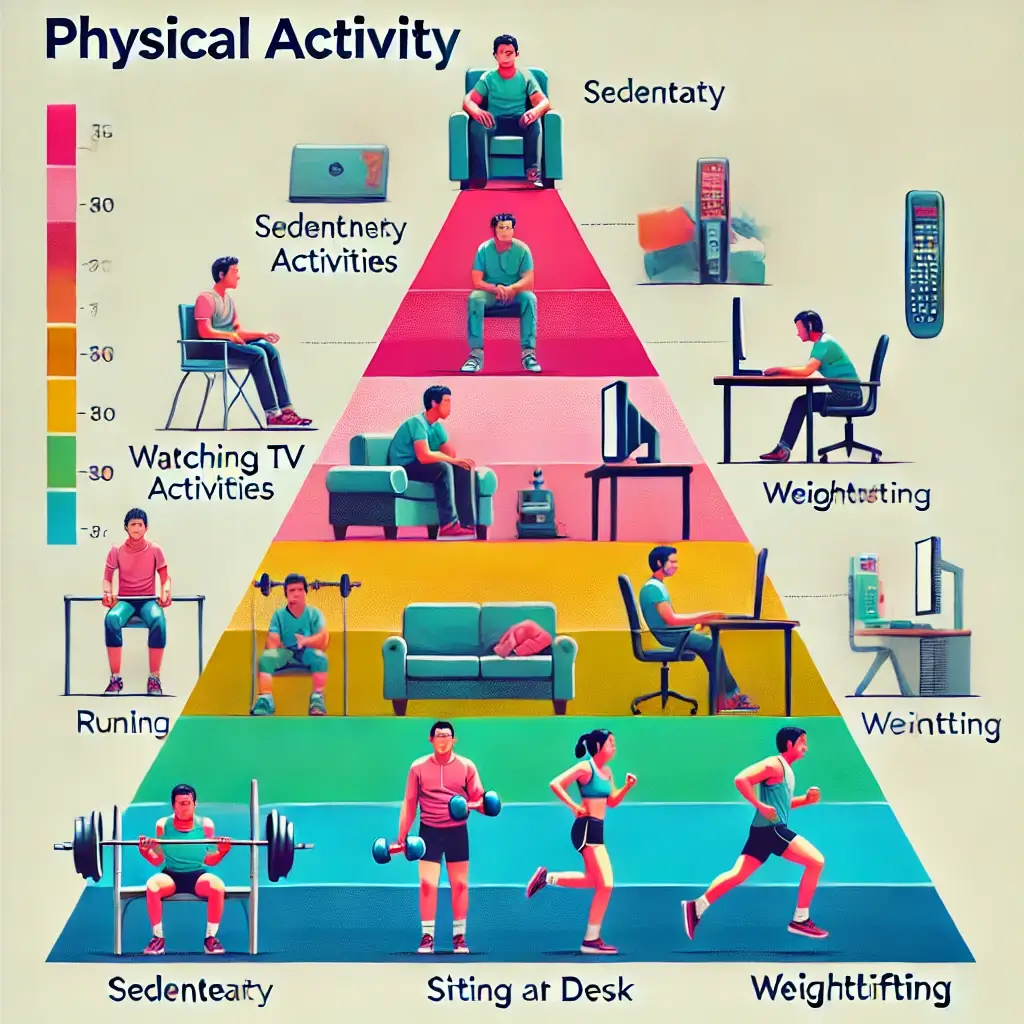What Is the Physical Activity Pyramid?
The Physical Activity Pyramid is an encompassing visual system created to break down all physical activity into differing categories and provide guidance on just how much time you should be spending on each type, using the pragmatic F.I.T.T.E. dictum. It's a blueprint for healthy living, guiding you in what to do and when in order to make movement a priority. So where on the Physical Activity Pyramid do sedentary activities belong? This is a question frequently asked as individuals attempt to get their habits into balance, and we will discover the answer while discovering this organized guide in detail. For those curious about structuring their day, where on the Physical Activity Pyramid do sedentary activities belong? is a key starting point.
Answer: Where on the Physical Activity Pyramid do Sedentary Activities Belong?
Sedentary behaviors reside in the uppermost category—level 4—of the Physical Activity Pyramid, occupying the pinnacle as a category to use with reservation. Where on the Physical Activity Pyramid do sedentary activities belong? Right at this top tier, as the obvious advice in this case is to limit or cut back drastically on the time devoted to such low-energy, largely sitting activities. By reducing sedentary activity and adopting more active options, you unlock a wealth of health advantages, such as enhanced circulation, improved mood, increased muscle strength, and even sharper mental focus. Restricting these activities isn't merely about physical well-being—it's a move toward a more dynamic, active life. Thus, where on the Physical Activity Pyramid do sedentary activities belong? remains a critical question with a clear answer: level 4.
What is the F.I.T.T.E Principle?
The F.I.T.T.E. Principle—Frequency, Intensity, Time, Type, and Enjoyment—is a flexible system that assists you in making your physical activity plan fit your needs and lifestyle. It's an easy-to-use method that keeps your exercise routine fresh, stimulating, and maintainable by inviting spontaneous tweaking and refining. Being a beginner or an experienced mover, this principle guarantees your activities are enjoyable and efficient, keeping monotony at bay from sabotaging your progress. When considering how to apply this, where on the Physical Activity Pyramid do sedentary activities belong? helps frame the need to minimize inactivity.
Frequency
Frequency is all about consistency—how frequently you do a specific activity. This might be the number of times you move in one day or over the course of a week, providing you with a rhythm to construct your habits upon.
Intensity
Intensity is a measure of how hard you work at an activity. It's the distinction between a casual walk and a fast jog, or holding a light dumbbell versus a heavier barbell—it's how much you stress your body in the effort.
Time
Time measures the amount of time you spend doing an activity, providing flexibility in measurement. Whether it's a 30-second stretch, a 20-minute walk, or doing multiple sets and repetitions, this component allows you to measure how long you're being active.
Type
The activity you do corresponds to the specific levels of the Physical Activity Pyramid, each with a specific purpose:
Everyday motions – Level 1: The base of daily movement
Cardio or fun activities – Level 2: Fun that gets your heart rate up
Relaxation, strength, and stretching – Level 3: Balanced strength and flexibility
No-active time periods – Level 4: Where inactive habits live
Where on the Physical Activity Pyramid do sedentary activities belong? They sit at level 4, highlighting the need to shift toward lower levels.
Enjoy
Enjoyment is the F.I.T.T.E. principle's secret sauce. Choosing activities that get you going—be it dancing to music you love or walking a gorgeous trail—completely changes everything. When you enjoy what you're doing, you're more likely to maintain it in the long run, making exercise feel like a pleasure and not an obligation.
Level 1 – Everyday Activity
Level 1 – Everyday Activity
Beneath the Physical Activity Pyramid is Level 1, the basic, real-world movements that you can easily incorporate into your daily life. Level 1 is all about developing a habit of activity into the fabric of your daily routine, and it doesn't involve going to the gym. Where on the Physical Activity Pyramid do sedentary activities belong? Not here—this level is about staying active.
Everyday
The objective here is to make movement a priority and eliminate sitting as much as possible, lessening sedentary time's hold on your routine.
Frequency – Aim for 5-7 days per week, making it a near-daily habit
Intensity – Keep it light to moderate, comfortable yet purposeful
Time – Focus on frequent bursts of activity woven throughout your day
Here are some creative ways to stay active in your daily grind:
Interrupt sitting with a stand or quick walk every 20-30 minutes—ideal for office workers or couch-watchers
Forego the car in favor of walking to the corner market or café
Spend time cultivating your garden, pulling weeds, or planting flowers
Park on the opposite side of the parking lot when driving to work, school, or the store
Bump up extra steps by using the longer route to the kitchen or mailbox
Walk your dog—or a friend's pup—around the block at a brisk pace
Forbid the elevator and take the stairs, even for a single flight or two
Cycle a bicycle or put on your walking shoes to ride to work or the health club
Bag your groceries manually rather than filling a cart
The trick is to become creative—turn daily moments into chances for movement! Where on the Physical Activity Pyramid do sedentary activities belong? Far above this active foundation.
Level 2 – Aerobic and Recreational Activity
Level 2 Aerobic and Recreational Activity
Level 2 of the Physical Activity Pyramid ramps up with cardio-based exercises and lively recreational activities, meant to make your heart work and your energy surge.
Frequency – Aim for 3-5 days a week for a good routine
Intensity – Gradually increase from moderate to vigorous, based on your fitness level
Time – Total 150-300 minutes a week, distributed over your sessions
The following chart presents aerobic target heart rates for moderate to vigorous activities, based on age (1). Moderate is 50-70% of your maximum heart rate, and vigorous ranges to 70-85%, providing you with clear-cut criteria to work towards.
Aerobic Activity
Cardio exercises are endurance activities that you can maintain over longer periods, gradually increasing your heart rate and maybe sweating—although you shouldn't feel breathless.
If you're shooting for moderate intensity, the Talk Test is your reference point: you can chat but not sing a chorus (2).
Examples to try:
A fast walk around the park or neighborhood
A steady bike ride on a trail or city streets
Swimming laps at a leisurely but rhythmic pace
A light jog on a treadmill or outdoor route
Taking a spirited aerobics or Zumba class
Dancing to fast music in your living room
As your fitness level improves, these will be less challenging, allowing you to lengthen your sessions without trouble. To keep things challenging, experiment with Frequency, Intensity, or Time, and select activities that put a smile on your face! Where on the Physical Activity Pyramid do sedentary activities belong? Not in this energetic tier.
Recreational Activity
Leisure activities add a social or competitive element, usually with teammates or partners, with efforts that vary from high to low. Think of a game of soccer: you may dash to pursue the ball, jog to move into position, or trudge off for a break, taking your heart rate on a wild ride.
Examples:
Kicking a soccer ball around with friends
Shooting hoops in a pickup basketball game
Rallying in a tennis doubles match
Martial arts kicking and blocking
Spinning through a salsa or swing dance evening
Hiking up a slope on a Saturday hike
These activities mix pleasure with exercise, holding your attention through variety and socialization.
Level 3 – Leisure, Flexibility, and Strength Activity
Level 3 Leisure, Flexibility, and Strength Activity
Level 3 of the Physical Activity Pyramid splits into casual leisure activities, flexibility-building stretches, and strength-building exercises, providing a well-rounded strategy to physical well-being. Where on the Physical Activity Pyramid do sedentary activities belong? Above this balanced level.
Leisure Activity
Leisure activities get you moving—walking, standing, or getting around—without necessarily getting your heart rate to moderate levels. These are the relaxed activities that still beat the alternative of sitting still.
Frequency – 2-3 times per week
Intensity – Light to moderate, easy effort
Time – Depends on your mood and schedule
Activities to enjoy:A game of golf with a cart or walking
A leisurely game of softball with the family or office mates
Cleaning up around the house or light housework
A peaceful walk in a park or along the beach
These get you moving without requiring too much, so they are great for unwinding or meeting new people.
Flexibility
Stretching exercises are flexible enough to accompany your daily routine, increasing mobility whenever you require it.
Frequency – 3-7 days a week, as frequently as feels good
Intensity – Gentle stretching, nothing forced
Time
Hold each stretch for 10-30 seconds—don't bounce
Repeat each movement 3-5 times for optimal results
Examples to include:
Easy stretches for your back, legs, or arms
A relaxing yoga session with movements such as downward dog or cat-cow
Flexibility exercises keep your muscles flexible and joints loose, perhaps preventing strains or stiffness.
Stretching Tips:Begin with a short warm-up or stretch after exercise for safety
Balance your stretches, exercising both sides of your body
Avoid rapid, jerky movements that might strain you
Leave joints relaxed—don't lock or overstretch them
Stretch until you feel a gentle pull, but don't go beyond pain
Breathe slow and deep—holding your breath defeats the purpose
Listen to your body and stop if something doesn't feel right!
Strength Training
Technique trumps load when it comes to muscle-building—lifting too much too quickly begs for injury.
Strength exercises are advised 2-3 days a week, preferably all the major muscle groups—legs, core, arms, and back—with 8-10 separate moves. Don't omit those squats and lunges!
Start with lighter weights and more reps: aim for 2-3 sets of 8-12 reps for each exercise to develop strength in a safe way.
Frequency – 2-3 times weekly, allowing muscles time to recover
Intensity – Variable, trying to work your muscles hard but not too hard
Time – 2-3 sets of 8-12 reps per exercise
What is a Rep?
A rep is one whole repetition of an exercise, such as coming down with a weight to your chest on a bench press and going back up to the top.
What is a Set?
A set groups 8-12 reps together as one attempt, giving your muscles a concentrated workout.
How do you choose the right weight?Struggling before 8 reps? It's too heavy—trim back the load
Doing 12 reps without breaking a sweat? It's too easy—add a little more
Strength Training Safety Reminders:Don't grip or hold your breath—keep it flowing
Exhale while lifting or pushing, inhale while lowering back down
Don't swing weights or lock joints to be safe
Some minor soreness for a day or two is okay—it's normal
Sharp pain is not okay—stop right away if it hits
Make your range of motion smooth and pain-free
Level 4 – Sedentary Activity
Level 4 – Sedentary Activity
The goal at level 4 is to minimize the time spent here as much as you can. Where on the Physical Activity Pyramid do sedentary activities belong? They're sitting at the very top, indicating that they need to be reduced. For clarity, where on the Physical Activity Pyramid do sedentary activities belong? remains a pivotal question pointing to this tier.
Sedentary Time
Level 4 is the domain of sedentary activities—those tied to sitting, reclining, or minimal motion. Where on the Physical Activity Pyramid do sedentary activities belong? This uppermost tier, which we’re encouraged to limit to boost overall health. When planning your day, where on the Physical Activity Pyramid do sedentary activities belong? serves as a reminder to prioritize lower levels.
Examples of sedentary moments include:
Binge-watching TV series or scrolling through videos
Sitting at a desk or laptop for extended stretches
Remaining seated or idle for 30 minutes or more without a break
Reducing these habits releases time for the lower, active levels of the pyramid, synchronizing your day with movement and energy. Where on the Physical Activity Pyramid do sedentary activities belong? Always at the top, urging a shift downward.




